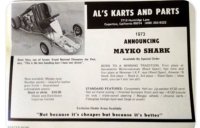I've played around this year drawing a kart. All the details are there, as best as I can remember. On the left rear there's a bracket, it's vertical, it's fixed in place. A cassette and bearing, riding on the axle, are bolted to the bracket. The brake caliper also bolts to the bracket, but not to the cassette. If I raise or lower the frame, the axle doesn't move, the bearing cassette doesn't move, (it's holding the bearing and the bearing is riding on the axle) only the frame and the caliper move. In an arc. That's misalignment to me. Not much, but definitely not 0.

